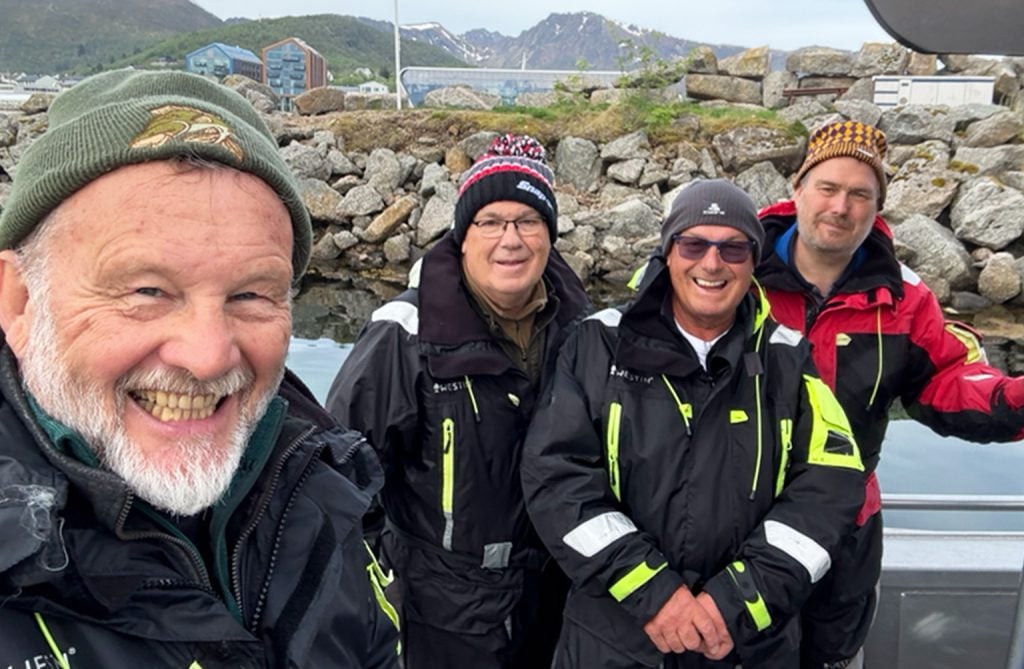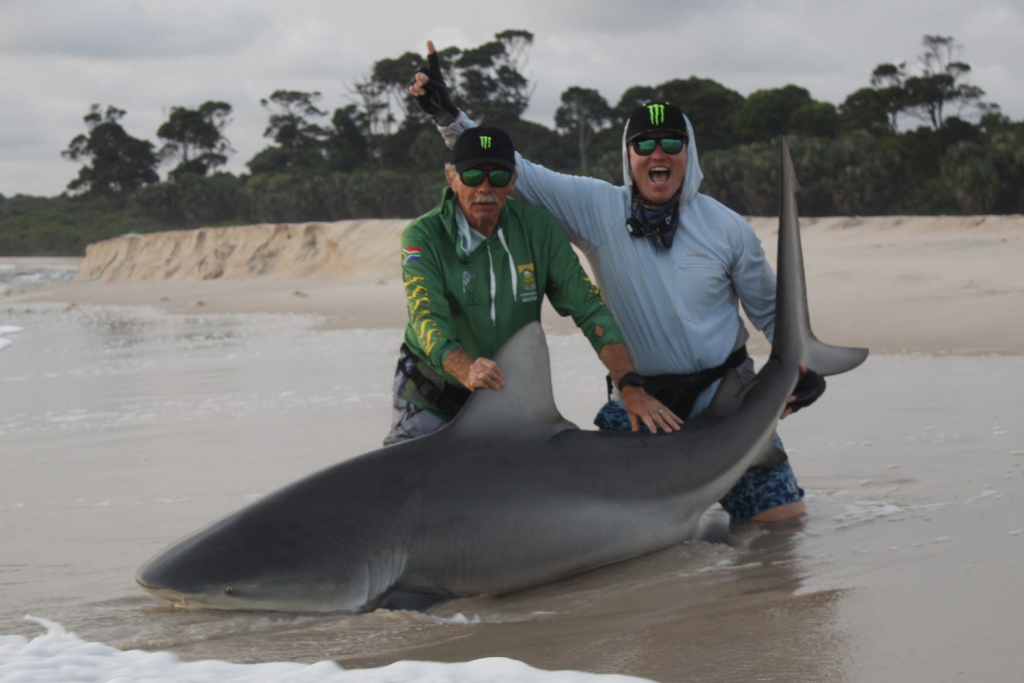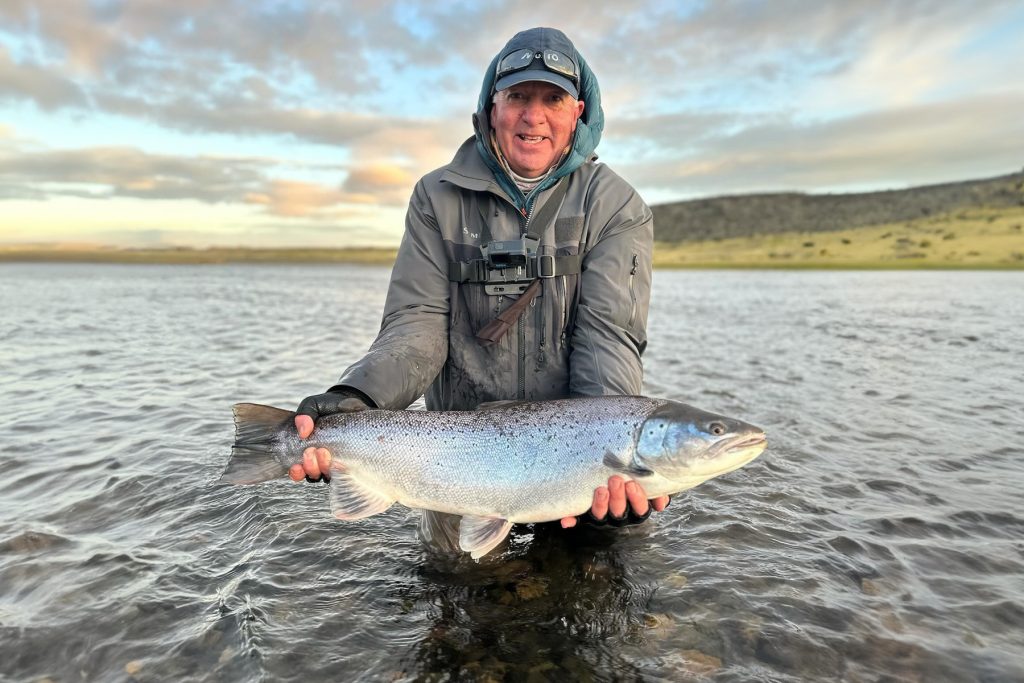Matt had left Norway after week 1 leaving Ross to fish the second week by himself, he had some plans to put in place to try and find a big Halibut from the shore. Did he succeed in his mission, read below to find out.
DAY 7 – It had been seven days since my arrival in the Lofoten Islands, I had just waved goodbye to Matt and I was on my way to scout another new and exciting venue close to the apartments. At this point, it was mid-day, the sun was shining and a lovely warm breeze was gusting through the car window as I navigated my way along the ice-covered roads. The venue I had chosen to look at this day, which we had pre-named ‘The Crowes Nest’ was potentially a very special one, it was not like any other venue we had previously visited. Its location alone guaranteed that there would be a good chance of a strong tidal pull and thanks to my trusty Navionics phone app, I could see that within easy casting distance of the rocks was a 12m deep channel that ran between the mainland and a reef a few hundred metres offshore. It just screamed fish!


As I pulled up a few hundred metres from the mark, everything looked spot on. I stuck on my Shimano jacket, slipped on my Grubs studded boots and began fighting my way through knee deep snow to access the rocks. The closer I got though, the more apparent it became that luck was not on my side, for the ledge I had planned to fish from was now cut off from the mainland. This one would have to wait until the following day.
Not to be discouraged, I headed back to base to re-think my plans, eventually settling on a rock mark thirty-five minutes to the south of Napp. This mark was extremely easy to access, being just a few minutes walk from the car. The rocks were flat and comfortable, the depth was a little over 40m, but most importantly, the ground was for the most part clean, with the only obstacle being a kelp covered lip at my feet. To make sure this didn’t affect my fishing, I opted to use a single hook pulley rig with a rotten bottom clip for my lead. I also changed my snood line to a 60lb fluorocarbon, as its stiffer and more abrasion resistant qualities would better suit this ground than a similar breaking strain monofilament. Confidence was now high that should I hook anything of decent size, I had given myself the best chance possible of landing it. The only thing left to do was whip a nice belly section of bluey on to my hooks and cast out. It was game on.


It didn’t take long for the first bite of the day to come about. A few solid bangs followed by a nice slack liner. I wound down until I was tight to the lead and then lifted into it, immediately feeling a resistance. A short fight ensued, then up popped a nice plump, well-conditioned cod from out of the kelp below. This pattern of quick bites continued for around ninety minutes, almost every cast resulting in a chunky codling between 3-5lb. However, after the fast start, things dramatically slowed down. I can only guess that the large shoal that had been in front of me for the last two hours had moved on with the tide. I stuck it out for a while longer, landing a couple more fish in the process, before heading back to camp to sort my gear, eat a decent meal and get an early night.
DAY 8 – I woke up at 07:00 feeling fresh. I was in a bit of a rush, so stuck my porridge in the microwave, nipped out to the drying room/freezer room to get my warm gear on/grab my bait, then I ran back to the apartment to inhale my breakfast, burning the roof of my mouth in the process. I was so excited at this point, I very nearly left without loading my rods into the van, but luckily I caught sight of them in the rear-view mirror before setting off. Now, let’s be honest, there was only one place I was heading on this day, which of course was The Crowes Nest. The earlier start meant that I arrived a good hour before low water this time, giving me plenty of time to leisurely wander down to my chosen ledge.
Just like the previous day, the sun was out; the wind, which had switched North Easterly was practically non-existent and considering it was early March, it was surprisingly warm. I pulled the highlanders from my rod bag, tightened my reels in to place and clipped on a pair of heavy-duty up and over rigs, built using 150lb rig body, 300lb breaking strain swivels, 250lb snood line and a pair of size 9/0 Cox and Rawle Ultra Chinu hooks. Now I should mention at this point, that the reason I had chosen to fish this heavy was purely down to the size of the halibut I could potential find myself hooked into here. It’s no secret that the boats catch them to over 100kg very close by, so I wanted to be prepared should something that size take a liking to one of my baits.


The first four hours of fishing were very slow indeed and passed by without any action whatsoever. The tide to this point had been very slowly trickling from right to left and my baits were staying put, the first of which I’d cast left towards an offshore reef and the second straight out in front of me towards the channel I had seen on the admiralty charts. As half tide approached and it dawned on me I was now cut off, like a switch, the tide suddenly picked up and changed direction. I was just about able to continue fishing with two rods for a further hour, but it soon became unpractical to continue this way, so one rod went back in the bag and I opted to fish hard with the one rod I had left.
Bait after bait, I continued to cast uptide and to my left, allowing plenty of slack line to get my grip lead to set in place. The tide was now racing so hard from my left that even with 8oz on, it would still trip out on occasion, pinging my rod tip backwards before resetting itself a few yards further down tide. I’m not going to lie, my initial optimism was fading rapidly at this point. It was high water and I knew full well I wasn’t going anywhere for another three hours at least. I had no option other than to persist, so once again, I reeled in on the half hour, changed my bait and cast up to my left.


A further twenty-five minutes passed by and it was nearly time for another bait change, when my tip sprung back once more. Thinking it had tripped out again, I ignored it at first, but as my tip bent over more and more, it soon became clear that this was not just the tide. Before I had the chance to react, line had started peeling from my reel at a rather scary rate of knots, lifting the butt section up off the deck, even on a relatively light drag setting. I grabbed the rod, steadied myself on the rocks and started to tighten the star drag. It made very little difference though. This fish was heading seawards and there wasn’t a lot I could do about it. Rod fully bent over, I held on for dear life as this fish emptied half of the line from my reel with relative ease, showing no signs of slowing down in the process. There was a real danger of getting spooled here, so I took a gamble, thumbing the line in an attempt to slow the fish down. It worked. I’d stopped the first run; but this fight was far from over.
Powerful head shakes came next as the desperate fish attempted to throw the hooks, but the tide had turned slightly in my favour. I made no delay in gaining line back whilst I could, pumping the rod hard and reeling like a man possessed when the opportunity presented itself. In no time, I had gained half the line back and was feeling good about the whole situation, but just as I was getting confident, the fish ran again, taking another thirty yards of line, this time with much less speed. It was obvious the fish was tiring, so I chose to be patient from here on in, gaining line back a metre at a time until I finally caught my first sight of the fish some ten minutes later. It was a halibut and a big one at that.


I backed my drag off a little and once again used my thumb to control the reel. The fish came up so nicely until it caught sight of me, at which point it shook its head violently, turned and bolted back down to the bottom. My line at this point was going straight through the kelp covered ledge below me and had the fish ran horizontally at any point, it would have been game over, but luck was on my side this day. Three times this repeatedly happened, before finally at the fourth time of asking I managed to stick the gaff up through its bottom jaw. To say I was happy is a big understatement. At 142cm in length and just shy of 37kg (82lb) in weight, this was fish of the trip by a country mile and I had landed it solo from a mark that has probably never seen another shore angler. It doesn’t get much better than that!


I composed myself for a minute whilst the fish thrashed violently on the rocks, took my chance to quickly remove my chinu from the corner of the mouth and then carried it up the rocks to a deep pool that had been left by the dropping tide. It was very heavy and extremely awkward to photograph whilst on my own. In the end, I gave up and tried to release the fish in a gulley behind me, but it had given so much in the fight that it was spent. I stood in the water with it for a good ten minutes, it’s gills still moving, but it’s energy had gone. I sat down, a bit gutted at the whole situation, before I decided to pack my gear up for the day, even though it would be another two and a half hours before I could get off the mark. It was certainly a bittersweet end to what had been a fantastic day in Norway, but on the plus side, I knew the fish would not go to waste.
DAYS 9 – In complete contrast to the two previous days, the weather was grim on this day. The wind had picked up to 45kmph from the North East, there was driving snow and the temperature had dropped to -6 with a real feel of -14. Twinned with the fact that I was aching all over from the previous day, my will power to go out and brave the weather was rather low. But there was no time to relax, I was there to fish and one of the reasons I love the area around Nappstraumen so much, is that it doesn’t particularly matter which way the wind is blowing, there is always somewhere you can tuck in out of the wind and find comfort.


So, after a well earned lie-in, I packed the van and headed south for the afternoon. I knew by this point that if I could find a mark with a depth of 35m or more, there was a very good chance I would pull out a few cod and maybe a few more of the other iconic Norway species such as Wolffish, Lumb and Ling. It didn’t take long for me to line up several venues to look at, with all of them being within a fifteen-minute drive of each other. The first mark I checked out looked lovely from the road, but a lack of parking options meant that it was no good, so it was on to the next mark.
The second mark I looked at was much more like it, decent parking close by, the rocks were comfortable and I had around 45m of water to cast into. Going with the rotten bottom pulley rig again, I soon found myself hooking into fish, with the majority being cod in the 3-5lb weight class. However, this particular mark also seemed to have a good head of lumb, which were a welcome change from the masses of cod that I’d been getting accustomed to. I fished this mark for a little over six hours, packing up shortly after dark when the bite seemed to dry up.


DAY 10 – The weather was much the same for my penultimate day in Nappstraumen, so I planned to head south once again to the deep-water. Seeing as it would be my last full days fishing, I decided to go all-out for a bigger cod. For the best chance of this, I would need to be prepared, so I spent a few hours in the morning prepping baits ready for the day ahead. My bait of choice for the week had been bluey, so I made around 30 perfect sized baits up, four of which I whipped on to my hooks, ready to be cast straight out as soon as I arrived on the mark. The rigs I didn’t need to alter much at all, but on a few of them, I increased the strength of the snood to an 80lb fluorocarbon, for extra abrasion resistance.
By 09:30 the van was loaded, by 10:00 I was fishing and by 10:15 I’d landed my first cod of the day. It seemed as though I’d hit it just right again, with every cast for the next few hours producing either a fish or a missed bite. By 14:00 I’d had over twenty cod and a handful of lumb, but nothing that stood out as a special fish. I knew they’d be there in amongst the masses of smaller fish, so it was just a case of perseverance. Eventually, after landing over thirty cod between 3-6lb, I hit into something much better. This fish was hanging deep and hugging the ledge in front of me, so I was made to use all my skills during the fight. Constantly giving out and taking up slack line, I managed to inch the fish up through the water column, before finally it appeared from deep in the kelp. It was so lightly hooked, I dared not try to beach it on the rocks, so I slid down to water level to chin it. This was a much better stamp of fish, somewhere in the region of 15-20lb and in lovely condition. After a few self timer photo’s, I slipped it back and watched as it powered back down to the depths. It was job done. What a day though, so many fish I ended up losing count and a nice cod to top it off.


DAY 11 – The end was near, so my final day in the Lofoten Islands was a bit of a chill down. It was for the most part, spent driving around looking at a few marks for later in the season, a few of which I’m very excited to try. At around 16:00, I headed back to the apartments to pack my gear away, after all, I was flying at 05:55, so I had to be up at stupid o’clock to get to the airport on time.


THE ROUND UP – So, I’d spent the last few weeks doing what I love, fishing new venues in an area that has barely been discovered by shore anglers and landing fish that I could have only dreamed of catching beforehand. In just 10 days, myself and Matt had achieved what would usually take months to do. Aside from the fishing, the area is just stunning, the accommodation is complete luxury and to be honest, I just can’t wait to get back there now and see what else this exciting area has to offer. Take me back!








